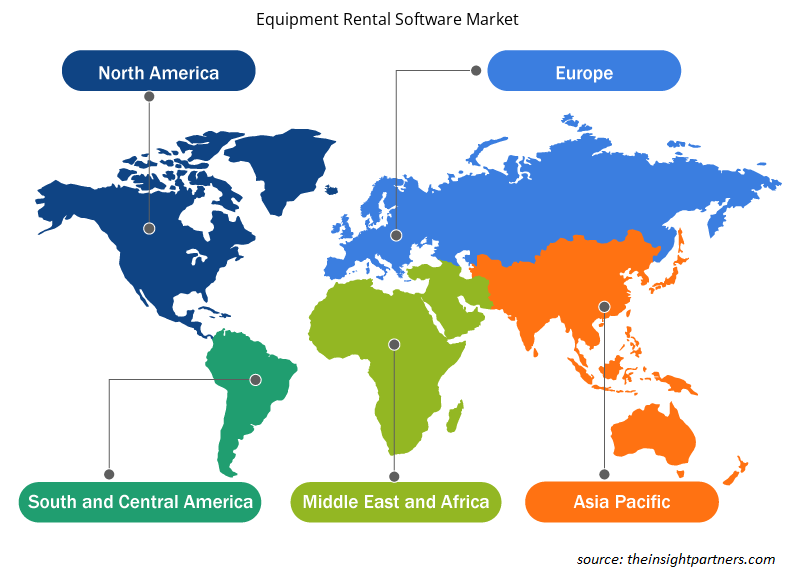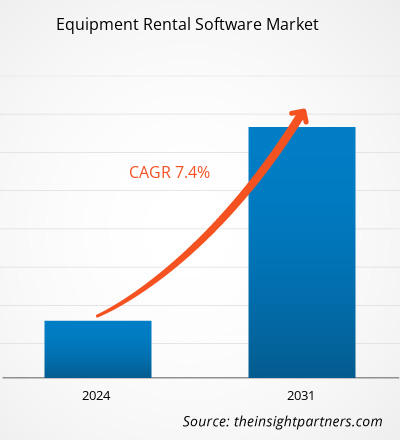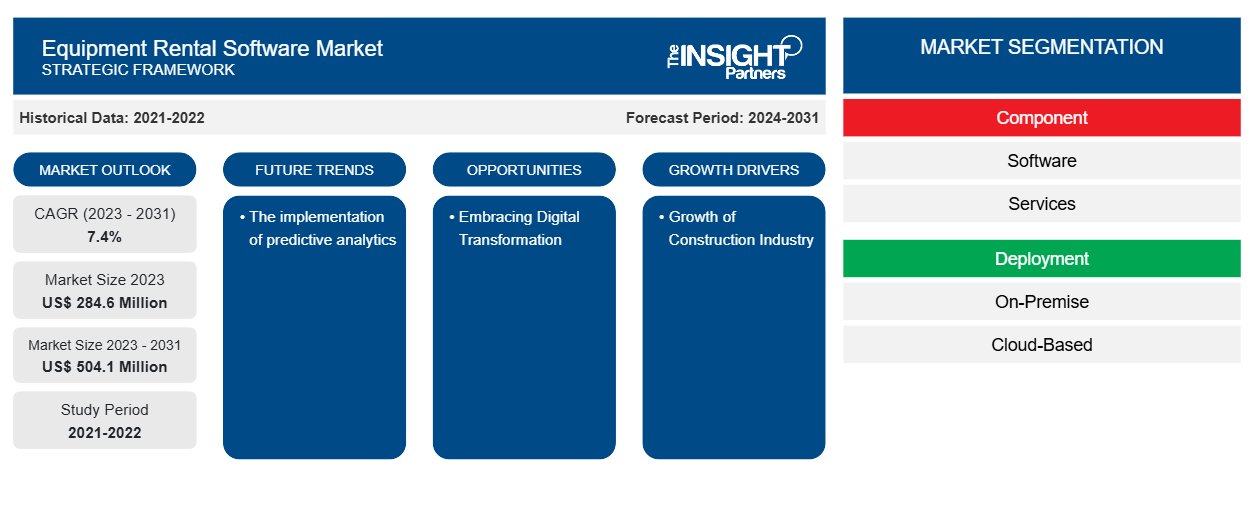Le marché des logiciels de location de matériel devrait atteindre 504,1 millions USD d'ici 2031, contre 284,6 millions USD en 2023. Le marché devrait enregistrer un TCAC de 7,4 % au cours de la période 2023-2031. La mise en œuvre de l'analyse prédictive devrait rester une tendance clé du marché.CAGR of 7.4% during 2023–2031. The implementation of predictive analytics is likely to remain a key trend in the market.
Analyse du marché des logiciels de location de matériel
Les logiciels de location d'équipement sont conçus pour utiliser efficacement les ressources disponibles tout en garantissant que chaque aspect de l'entreprise est couvert, de la formation et du support client à la productivité et à la gestion financière. Le but d'un logiciel de location d'équipement est d'aider à gérer le parc d'équipements qu'une organisation possède. Ce logiciel peut profiter à une organisation au-delà de la connaissance de ce qui est disponible et de l'emplacement de la location. Un logiciel de location d'équipement performant permettra à une organisation de faire ce qui suit et d'en récolter les bénéfices. L'avantage de toutes ces fonctionnalités, dans l'ensemble, est une augmentation de la productivité et de la rentabilité. La différence entre un bon logiciel de location d'équipement et le meilleur logiciel de location d'équipement réside dans la profondeur et la facilité d'utilisation de ses fonctionnalités. HBS Systems va au-delà des fonctionnalités de base du logiciel de location d'équipement avec une multitude de fonctionnalités supplémentaires qui peuvent être utilisées n'importe où sur des appareils mobiles dans un système facile à utiliser .
Aperçu du marché des logiciels de location de matériel
Les logiciels de location d'équipements fournissent aux entreprises des outils pour rationaliser les processus, organiser les opérations, gérer les actifs et calculer l'amortissement. Grâce à cette solution logicielle, on peut également attribuer des équipements aux employés, planifier la maintenance et effectuer des opérations de back-office telles que la comptabilité et la tenue de livres. Les logiciels de location d'équipements peuvent aider les entreprises de taille moyenne et les petites entreprises à croissance rapide à atteindre leurs objectifs et à se développer grâce à des avantages tels que la réduction des temps d'arrêt des équipements, l'organisation des plannings, la génération de rapports et d'informations, la gestion des factures et des documents, etc.
Personnalisez ce rapport en fonction de vos besoins
Vous bénéficierez d'une personnalisation gratuite de n'importe quel rapport, y compris de certaines parties de ce rapport, d'une analyse au niveau des pays, d'un pack de données Excel, ainsi que d'offres et de remises exceptionnelles pour les start-ups et les universités.
-
Obtenez les principales tendances clés du marché de ce rapport.Cet échantillon GRATUIT comprendra une analyse de données, allant des tendances du marché aux estimations et prévisions.
Moteurs et opportunités du marché des logiciels de location de matériel
La croissance du secteur de la construction devrait favoriser le marché
Les projets d'investissement public donnent une impulsion majeure au secteur de la construction. Cela comprend des mégaprojets dans des secteurs tels que les infrastructures urbaines, les transports, les routes, l'irrigation et l'immobilier. L'Autorité aéroportuaire indienne investit 7,3 milliards de dollars dans la construction de nouveaux aéroports, l'agrandissement et la modernisation des aéroports existants et le renforcement des pistes, des blocs techniques et des tours de contrôle. Elle agrandira également les trois aéroports PPP de Delhi, Bengaluru et Hyderabad, avec un investissement de 3,59 milliards de dollars d'ici 2025. Le logiciel de location d'équipements de construction pour l'industrie des matériaux de construction garantit que vous disposez d'une solution fiable et fiable qui répond aux besoins des clients. Avec des fonctionnalités spécifiques telles que la tarification des équipements industriels, la maintenance préventive, la gestion des numéros de série et les modules de réparation, Sirius-e a été conçu pour répondre à tous les besoins de location d'outils et d'équipements. La capacité de Sirius-e à gérer les locations, les ventes et le service dans un seul logiciel de location intégré apportera des avantages significatifs à votre entreprise de location de construction.PPP airports in Delhi, Bengaluru, and Hyderabad, with an investment of US $3.59 billion by 2025. Construction material industry construction equipment rental software ensures that you have a reliable and reliable solution that meets clients' needs. With specific features such as industrial equipment pricing, preventive maintenance, serial number management, and repair modules, Sirius-e was designed to meet all the needs of tool and equipment rental. Sirius-e’s ability to handle rentals, sales, and service all in one integrated rental software will bring significant benefits to your construction rental business.
Adopter la transformation numérique
L’avènement des technologies numériques offre aux entreprises de location d’équipements des opportunités sans précédent pour rationaliser leurs opérations, améliorer l’expérience client et stimuler la croissance. L’adoption d’initiatives de transformation numérique, telles que les systèmes de gestion de location basés sur le cloud, le suivi des équipements via l’IoT et les applications mobiles pour l’engagement client, permet aux entreprises de garder une longueur d’avance. En tirant parti de l’analyse des données et des informations prédictives, les entreprises peuvent optimiser l’allocation des ressources, anticiper les besoins des clients et prendre des décisions commerciales éclairées. Microsoft Dynamics 365 Business Central peut être une solution précieuse pour les entreprises de location d’équipements, en fournissant une plate-forme intégrée pour gérer efficacement divers aspects de leurs opérations commerciales.IoT-enabled equipment tracking, and mobile applications for customer engagement, enables businesses to stay ahead of the curve. By leveraging data analytics and predictive insights, businesses can optimize resource allocation, anticipate customer needs, and make informed business decisions. Microsoft Dynamics 365 Business Central can be a valuable solution for equipment rental companies, providing an integrated platform to manage various aspects of their business operations efficiently.
Analyse de segmentation du rapport sur le marché des logiciels de location d'équipement
Les segments clés qui ont contribué à l’élaboration de l’analyse du marché des logiciels de location d’équipement sont les composants, le déploiement, la taille de l’organisation et l’utilisateur final.
- En fonction du composant, le marché des logiciels de location d'équipements est divisé en logiciels et services.
- En termes de déploiement, le marché est segmenté en sur site et basé sur le cloud.
- Selon la taille de l’organisation, le marché est segmenté en petites et moyennes entreprises et en grandes entreprises.
- En termes d’utilisateurs finaux, le marché est segmenté en fabrication, construction, transport et autres.
Analyse des parts de marché des logiciels de location de matériel par zone géographique
La portée géographique du rapport sur le marché des logiciels de location d'équipements est principalement divisée en cinq régions : Amérique du Nord, Asie-Pacifique, Europe, Moyen-Orient et Afrique, et Amérique du Sud et centrale. Les activités de construction croissantes en Amérique du Nord et le besoin croissant d'efficacité opérationnelle des entreprises stimulent la croissance du marché. Divers acteurs en Amérique du Nord lancent des logiciels de location d'équipements. Par exemple, en septembre 2020, Orion Software a annoncé un accord avec Telus pour vendre et commercialiser la technologie GPS afin de compléter ses services de location. Les sociétés de location peuvent utiliser la plateforme Sirius e pour mettre à jour leurs compteurs en temps réel, facturer la surutilisation et déclencher des alertes de maintenance préventive. Le portail Web du portail client peut également localiser l'équipement sur le terrain sur un chantier de construction. Cette intégration avec la technologie Telus offre un avantage de déploiement significatif. Les sociétés de location peuvent obtenir une technologie standard qui fonctionne sur toutes les marques d'équipements et est très simple à installer.Telus to sell and commercialize GPS technology to supplement its rental services. Rental companies can use the Sirius e platform to update their meters in real time, invoicing overuse and triggering preventive maintenance alerts. The customer portal's web portal can also locate equipment in the field on a construction site. This integration with Telus technology provides a significant deployment benefit. Rental companies can get a standard technology that works on all equipment brands and is very simple to install.
Aperçu régional du marché des logiciels de location de matériel
Les tendances et facteurs régionaux influençant le marché des logiciels de location d’équipement tout au long de la période de prévision ont été expliqués en détail par les analystes d’Insight Partners. Cette section traite également des segments et de la géographie du marché des logiciels de location d’équipement en Amérique du Nord, en Europe, en Asie-Pacifique, au Moyen-Orient et en Afrique, ainsi qu’en Amérique du Sud et en Amérique centrale.

- Obtenez les données régionales spécifiques au marché des logiciels de location d'équipement
Portée du rapport sur le marché des logiciels de location d'équipement
| Attribut de rapport | Détails |
|---|---|
| Taille du marché en 2023 | 284,6 millions de dollars américains |
| Taille du marché d'ici 2031 | 504,1 millions de dollars américains |
| Taux de croissance annuel composé mondial (2023-2031) | 7,4% |
| Données historiques | 2021-2022 |
| Période de prévision | 2024-2031 |
| Segments couverts |
Par composant
|
| Régions et pays couverts |
Amérique du Nord
|
| Leaders du marché et profils d'entreprises clés |
|
Densité des acteurs du marché des logiciels de location de matériel : comprendre son impact sur la dynamique des entreprises
Le marché des logiciels de location d'équipements connaît une croissance rapide, tirée par la demande croissante des utilisateurs finaux en raison de facteurs tels que l'évolution des préférences des consommateurs, les avancées technologiques et une plus grande sensibilisation aux avantages du produit. À mesure que la demande augmente, les entreprises élargissent leurs offres, innovent pour répondre aux besoins des consommateurs et capitalisent sur les tendances émergentes, ce qui alimente davantage la croissance du marché.
La densité des acteurs du marché fait référence à la répartition des entreprises ou des sociétés opérant sur un marché ou un secteur particulier. Elle indique le nombre de concurrents (acteurs du marché) présents sur un marché donné par rapport à sa taille ou à sa valeur marchande totale.
Les principales entreprises opérant sur le marché des logiciels de location d'équipement sont :
- BCS Prosoft, LLC
- Booqable eSlJB Inc.
- EZRentOut
- Logiciel de location de siège social
- inspHire Ltd.
- MCS Global Ltd.
Avis de non-responsabilité : les sociétés répertoriées ci-dessus ne sont pas classées dans un ordre particulier.

- Obtenez un aperçu des principaux acteurs du marché des logiciels de location d'équipement
Actualités et développements récents du marché des logiciels de location de matériel
Le marché des logiciels de location de matériel est évalué en collectant des données qualitatives et quantitatives après des recherches primaires et secondaires, qui incluent d'importantes publications d'entreprise, des données d'association et des bases de données. Quelques-uns des développements sur le marché des logiciels de location de matériel sont répertoriés ci-dessous :
- EZRentOut a introduit une multitude de nouvelles fonctionnalités et améliorations. Les locations aux entreprises sont facilitées grâce au module de gestion des clients B2B. Les clients peuvent désormais utiliser un bouton d'enregistrement rapide pour des retours plus rapides et plus efficaces, facturer des tarifs de location en fonction de l'utilisation du bien et ajouter des graphiques à partir de rapports personnalisés directement au tableau de bord, entre autres fonctionnalités. (Source : EZRentOut, mars 2022)
- Point of Rental Software a étendu ses opérations en Afrique du Sud, car il s'agit de l'une des stratégies de croissance de l'entreprise ; l'entreprise cible les solutions logicielles de business intelligence en Afrique subsaharienne. (Source : Point of Rental Software., décembre 2021)
Rapport sur le marché des logiciels de location d'équipements : couverture et livrables
Le rapport « Taille et prévisions du marché des logiciels de location d’équipement (2021-2031) » fournit une analyse détaillée du marché couvrant les domaines ci-dessous :
- Taille et prévisions du marché des logiciels de location d'équipements aux niveaux mondial, régional et national pour tous les segments de marché clés couverts par le périmètre
- Tendances du marché des logiciels de location d'équipements ainsi que la dynamique du marché, comme les facteurs déterminants, les contraintes et les opportunités clés
- Analyse détaillée des cinq forces de PEST/Porter et SWOT
- Analyse du marché des logiciels de location d'équipements couvrant les principales tendances du marché, le cadre mondial et régional, les principaux acteurs, les réglementations et les développements récents du marché
- Analyse du paysage industriel et de la concurrence couvrant la concentration du marché, l'analyse de la carte thermique, les principaux acteurs et les développements récents pour le marché des logiciels de location d'équipements
- Profils d'entreprise détaillés
- Analyse historique (2 ans), année de base, prévision (7 ans) avec TCAC
- Analyse PEST et SWOT
- Taille du marché Valeur / Volume - Mondial, Régional, Pays
- Industrie et paysage concurrentiel
- Ensemble de données Excel
Rapports récents
Rapports connexes
Témoignages
Raison d'acheter
- Prise de décision éclairée
- Compréhension de la dynamique du marché
- Analyse concurrentielle
- Connaissances clients
- Prévisions de marché
- Atténuation des risques
- Planification stratégique
- Justification des investissements
- Identification des marchés émergents
- Amélioration des stratégies marketing
- Amélioration de l'efficacité opérationnelle
- Alignement sur les tendances réglementaires























 Obtenez un échantillon gratuit pour - Marché des logiciels de location de matériel
Obtenez un échantillon gratuit pour - Marché des logiciels de location de matériel